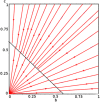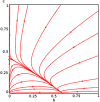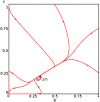Modelling the dynamics of two political parties in the presence of switching
- PMID: 27441137
- PMCID: PMC4938829
- DOI: 10.1186/s40064-016-2483-z
Modelling the dynamics of two political parties in the presence of switching
Abstract
This paper generalizes the model proposed by Misra, by considering switching between political parties. In the model proposed, the movements of members from political party B to political party C and vice versa, are considered but the net movement is considered by assuming that [Formula: see text] (a constant), which implies that the movement of members is either from party B to party C or from party C to party B. In this paper we remodel these movements through switching functions to capture how individuals switch between parties. The results provide a more comprehensive synopsis of the dynamics between two political parties.
Keywords: Modelling; Political parties; Simulations; Steady states; Switching function.
Figures











References
-
- Abrams PA, Matsuda H. Population dynamical consequences of reduced predator switching at low total prey densities. Deep Sea Res (II Top Stud Oceanogr) 2003;50:2847–2875. doi: 10.1016/j.dsr2.2003.07.001. - DOI
-
- Alvarez M, Nagler J. A new approach for modelling strategic voting in multiparty elections. Br J Polit Sci. 2000;31(01):57–75. doi: 10.1017/S000712340000003X. - DOI
-
- Belenky AS, King DC. A mathematical model for estimating the potential margin of state undecided voters for a candidate in a us federal election. Math Comput Model. 2007;45(5):585–593. doi: 10.1016/j.mcm.2006.07.007. - DOI
-
- Burden BC. Candidate positioning in us congressional elections. Br J Polit Sci. 2004;34(02):211–227. doi: 10.1017/S000712340400002X. - DOI
-
- Fieldhouse E, Shryane N, Pickles A. Strategic voting and constituency context: modelling party preference and vote in multiparty elections. Polit Geogr. 2007;26(02):159–178. doi: 10.1016/j.polgeo.2006.09.005. - DOI
LinkOut - more resources
Full Text Sources
Other Literature Sources

